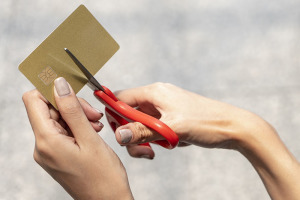Petunia is one of the most favorite ornaments of flower growers when decorating the site. The plant is grown not only in gardens, but also in apartments. It adorns with its bright flowering window sills, terraces, balconies, arbors and flower beds. Petunia is considered the most popular and widely used decorative floral element. It is quite easy to grow, it is unpretentious and able to delight its owners with flowering throughout the summer.
Petunia, which comes from warm America, became available to gardeners in Europe more than a hundred years ago. Breeders instantly drew attention to the lush and interesting bushes of the plant. Now, thanks to them, you can choose different types of petunias and their varieties. Recent developments of breeders are aimed at breeding bright orange and sunny flowers using rose genes. To grow such a wonderful plant at home is easy.
Petunia - the bright beauty of the gardens
The plant belongs to the nightshade family and is a bush that has different shapes depending on the species. This can be a small bush up to 20 cm in size or a plant with falling branches - a cascading, or ampelous, type of petunia. The stems and leaves form thick, soft greens. Coloring of flowers varies from white to lilac. The diameter of the inflorescences can reach 12 cm. Cascading petunia is considered the most spectacular and impressive species. Her stems, covered with colorful flowers, spread, rather than stand. Florists grow it in hanging flower pots, flowerpots and any other vertical structures. Growing petunias is a simple matter if all the conditions and rules for planting are met.

Almost all types of petunias are unpretentious, except for the terry look. Such a plant is more capricious, its breeding can cause a lot of trouble. However, the beauty of terry flowers and their size are impressive, so many growers take up the cultivation of petunias of this species.
Petunia growing conditions, soil
The technology of growing plants is reduced to compliance with certain conditions. In general, petunia loves loamy soil, but it also takes root well in ordinary garden soil, and some varieties can grow on poor soil. Reviews recommend not to take risks and grow your favorite in fertile soil, which will include peat, sheet land, turf and river sand. The ratio of the components is 1: 2: 2: 1. Experienced gardeners prefer to add nitrophosphate to the earthen substrate. In such a land, growing petunias will be a pleasure.
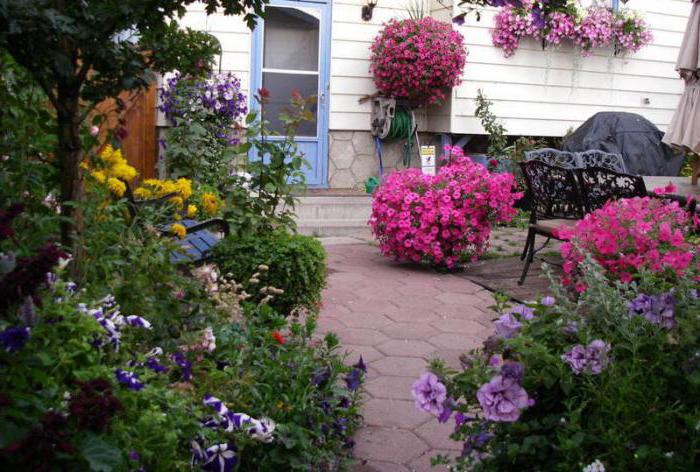
Ordinary garden land is also suitable for breeding petunias. Many gardeners note that the plant likes a slightly acidic environment, its greens become more juicy, and growth accelerates. Growing petunias, according to reviews, requires special lighting conditions. She prefers well-lit areas of the garden, but under the scorching rays of the sun, inflorescences can quickly fade. Therefore, a little shading will benefit the plant.
Lighting is one of the main conditions
Growing petunias at home or in the garden requires good lighting. Sunny clearings with little shading from the trees are an ideal place for petunias. Dark and damp areas do not contribute to the good growth and flowering of a fabulous plant. If we are talking about an ampel or cascade form, then the lighting conditions for it are the same.The sun should not burn delicate flowers and leaves, so a falling shadow from any buildings or trees is welcome. The soil should be moist, but not flooded. Excessive dampness will stop growth. Along with good lighting, petunia loves a light breeze. This will provide her with airing of the soil - that which petunia loves so much. Growing and caring for the plant will not be difficult if the lighting conditions and soil composition are observed.
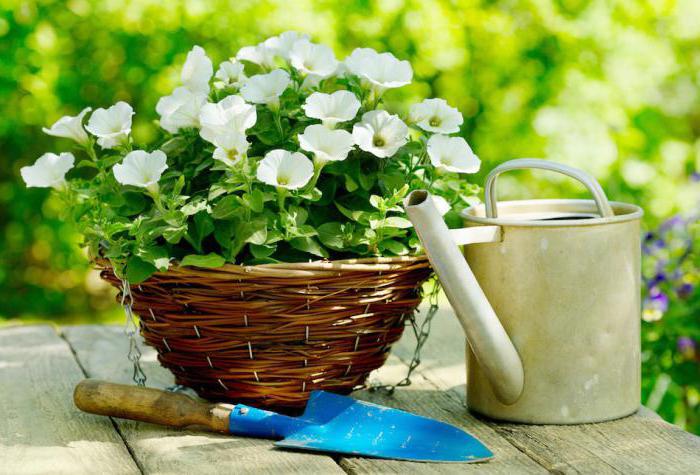
House growing conditions
At home, breeding a beauty will not be any different from growing in open ground. She will also need light and fertile, slightly acidic soil. Growing petunia seedlings at home requires a fairly high humidity and temperature up to 20-25 ° C. It is better to keep the already grown and formed bush on the windows of the south-east or south-west direction. Do not allow direct, burning sun to fall on foliage and petunia flowers. They will immediately turn yellow and dry. Watch the moisture of the soil, but do not overfill it, otherwise the plant will die due to the formation of root rot. Choose a room where you could ventilate the room - an additional, but important condition for such beauty as petunia. Growing from seeds at home will be successful if all these simple conditions and rules are followed.
Propagation of petunia seeds
The most common way to breed petunias is seeds. Reviews recommend purchasing seeds in the shell, since they are easier to plant in the soil, they are significantly larger. Sowing technology is reduced to soil preparation and maintaining the desired temperature - 22-25 ° C. The composition of the soil includes peat, humus, turf land and sand. Components are taken in equal parts. Growing petunia from seeds requires a container in which drainage must be present. It must be disinfected with a weak solution of potassium permanganate. The same procedure should be done with prepared soil. For disinfection, many experienced flower growers resort to the use of drugs such as Fundazol or Fitosporin-M.
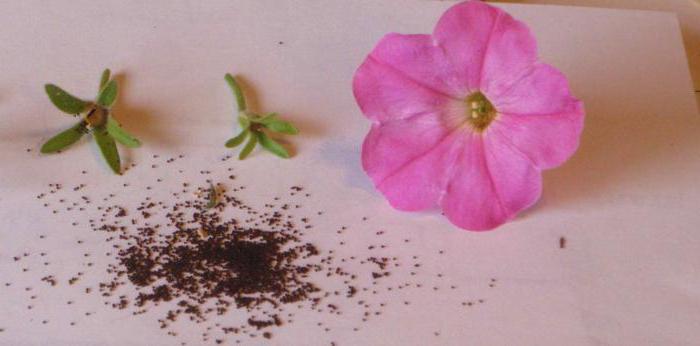
Seeds are sown in slightly moistened but not moist soil. They are best mixed with river sand. This will distribute the seed evenly and will not cause further problems with picking. After that, the container with seeds is closed with glass or film. Petunia seedlings should be grown at a temperature of 22 ° C. Failure to do so will result in poor seedlings or none at all.
The soil under the seedlings should be moist, but not moist. Always remove condensation from the glass cover. This will prevent the appearance of a black leg on seedlings - a disease that petunia does not tolerate. Growing from seeds at home also requires a lot of light. Put the box with seedlings on the lightest window sill - the southern direction. After the appearance of two or three leaves, seedlings are dived. As soon as small bushes are formed, and the root system is strong, you can continue to grow petunias in the greenhouse or plant it in open ground. It is also important to observe the timing of planting seedlings. Fast germination is a plus that petunia boasts.
Growing from seeds: when to plant?
Germination from a seed takes about one week. Always consider this fact, since seedlings require a lot of light. If the landing was made in February, then there is a risk of not providing the seedlings with the required sunlight. The optimal timing for planting seeds is considered to be the beginning or mid-March. Many are planting seedlings in early April.

Cuttings - the second method of reproduction
According to gardeners' reviews, cuttings allow growing an adult bush much faster. In contrast to the first method of propagation by seeds, cuttings already suggest the presence of an adult plant. The procedure for cutting cuttings is best done in mid-August.Cut off the lateral shoots of petunias, preferably with two internodes. Then the cuttings are dipped in “Kornevin” and planted in small glasses with light soil. The plant is placed in a shaded place. So the cuttings are sent for the winter. It is necessary to monitor the moisture content of the soil and fertilize with complex mineral fertilizers. In spring, the stalk is planted in open ground or in a permanent pot at home - where petunia will constantly grow.
Proper care
A prerequisite for the successful cultivation of a luxurious and dense plant is watering. The soil must always be moistened. Make sure that the earthen lump is moist, but not waterlogged. If a crust has formed on the surface, loosen it so that the root system has access to air. It is also necessary to ventilate the petunia if it is grown at home. When planting seedlings in open ground or a pot, the tops of the shoots are pinched. This will allow the plant to cluster, and not just reach up. In addition to watering and pinching the shoots, it is necessary to monitor the feeding of petunias.
Plant nutrition
When growing seedlings and transplanting them into the soil, to a permanent place, complex mineral fertilizers containing nitrogen compounds are introduced into the soil. Such top dressing enhances the growth of petunias. During the growing season, it is necessary to introduce complex fertilizers, for example nitroammophoska. In the second half of summer, the plant should already be fed potash-phosphorus fertilizers. At this time, nitrogen cannot be introduced into the soil, otherwise petunia will not be prepared for winter properly, as it will continue to grow abundantly under the influence of this growth enhancer. Constant care and top dressing contribute to the dense and abundant flowering of petunias.
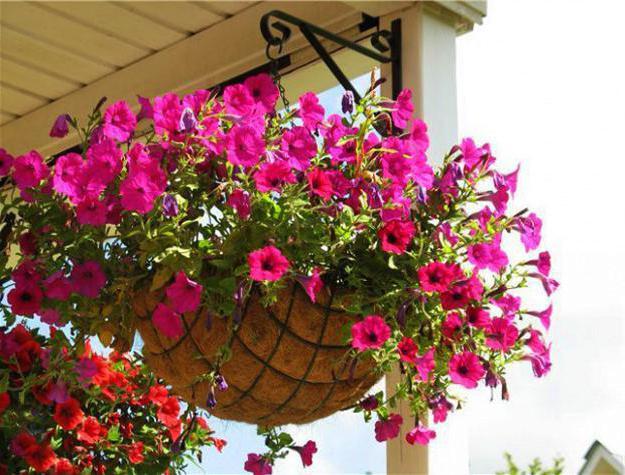
Ampelic, or cascading, petunia
Many gardeners prefer to breed ampelous petunias. The cultivation of this elegant plant species is not much different from the cultivation of bush varieties. But there are some nuances. For example, a hanging planter or flowerpot is best placed in a calm place. This variety also requires good lighting. Particular attention should be paid to watering ampelous petunias. The fact is that an earthen lump, as a rule, is not completely saturated with water. The upper layers of the soil remain moist, and the lower ones dry out. Therefore, it is important to carefully, but not often, shed an earthen lump. It’s okay if water flows from the holes in the bottom. Also, in pots at the bottom, it is necessary to place drainage from broken bricks or expanded clay. This will prevent water from accumulating in the root system. Root rot will have less chance of development. Feeding this plant occurs according to the same scheme as bush petunia.
Compliance with these small nuances will allow you to grow a picturesque cascade of flowers on a trellis or in a hanging pot. According to the reviews of those who grew both varieties of petunias, ampelous is preferable because of its amazing beauty and the ability to bring hanging flowerpots and planters into the house for the winter.

Landscaping - garden decoration with petunias
Many designers resort to petunias when decorating garden plots. Cascading views are very popular. They are great for landscaping vertical structures - arbors, trellises, verandas. Bright and attractive flowers give the impression of a fairy tale. Shrub varieties can be decorated with flower beds, stone or brick borders, floor flowerpots. Petunias look very favorably against a uniform, green lawn. Their lush flowers, like strokes of an artist, immediately attract attention. The use of this marvelous plant can be found both in the garden and in the apartment. At home, petunia becomes a decorative element that adorns window sills or balconies. You can also hang a flower pot with a plant and admire the flower cascades.
The sun, moist soil and gentle breeze are all that petunia loves.Growing from seeds (when to plant, we found out) is possible for both a novice amateur gardener and an experienced gardener. Knowledge of simple rules and their observance will allow you to grow a luxurious, picturesque cascade of fabulous flowers of petunias. According to gardeners, it becomes clear that petunia is their favorite flower in the decoration of the garden.

